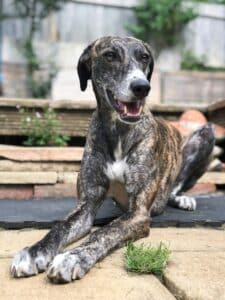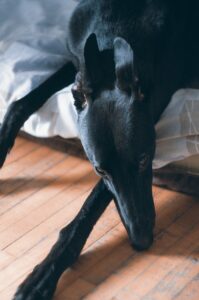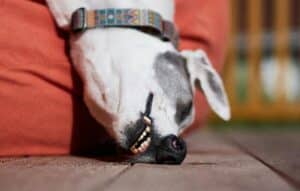Well, as April is International Adopt-a-Greyhound month we thought what better way to put a spotlight on these fabulous fellows than to dedicate a whole blog to them! People have often asked us why we always have greyhounds on PetMatch and we have also often heard comments about how they must be hard to look after so we figured we would provide a bit more insight into these sighthounds!
We partnered with the Irish Retired Greyhound Trust (we thought they would know a thing or two about greyhounds – yep, we are smart like that!) to get the inside scoop on all things greyhound and what makes greyhounds great hounds.
 Why are they called Greyhounds?
Why are they called Greyhounds?
Given the variety of different colour greyhounds you may have seen, it seems a bit of a misnomer to call these guys grey so what’s the story?! Well, nobody really knows with certainty how they got their name but some theories include that the name was originally ‘Grighund’ with ‘hund’ being an old word for hound while the meaning of grig remains unknown, or ‘grei’ and ‘hundr’ which combined to mean hunting dog.
Why are they called Sighthounds?
Whilst you probably think of greyhounds as racing dogs, they were originally hunting dogs. Sighthounds are a type of dog that hunted on the basis of sight rather than smell. Greyhounds are considered to be a sighthound alongside breeds such as Whippets, Salukis, Borzois, Afghan hounds and the wonderful Irish wolfhound. This terminology comes from what the dogs were originally bred and used for. The thin heads and eye placement of sighthounds enables them to have up to 270-degree vision…so it’s pretty safe to say you are not getting away with eating that snack!
Why do Greyhounds sometimes have two names?
Greyhounds will often have a pet name and a registered racing name if they are a retired racing greyhound which is why you will often see two names beside a greyhound that may be available for rehoming.
What’s the difference between a Greyhound and a Lurcher?
A lurcher is a sighthound crossed with another dog (often considered to be a cross with a terrier-type dog or collie). Often lurchers are greyhound crosses and so have a lot of physical features that resemble greyhounds. Whilst they may also have other characteristics or traits similar to greyhounds if they are a greyhound cross, as with any other crossbreed, they may also be heavily influenced by traits of the other pedigree(s) in their breeding, so, for example, they may have greater stamina and energy levels and different ways of learning to a greyhound.
Why do Greyhounds end up in need of rehoming?
Like any dog, greyhounds can end up in need of a home for a variety of reasons but, for greyhounds, there are also often dogs coming from the racing industry that are either been deemed unsuitable for racing or have been retired from racing. As Ireland has had a greyhound racing industry for many years, this is a key factor in us having a large population of greyhounds and greyhound-related breeds such as lurchers. Greyhounds are retired from racing anywhere between 2 and 5 years of age which is young when you consider that they can live up to 12-15 years.
 What is a Greyhound like as a family pet?
What is a Greyhound like as a family pet?
Whilst every dog is unique and will have its own personality, there are certain traits and characteristics that are quite common in greyhounds and can make them ideally suited to being great family pets and, often, a good choice for first-time dog owners.
Life Span
A greyhound has an average lifespan of around 12 to 15 years which can make them a great long-term companion. Whilst they do have some conditions that they can get, greyhounds are generally considered to be a breed that has very good health.
Size & Physical Attributes
Greyhounds are known for their almost regal appearance and, in fact, have quite a history for being associated with nobility and aristocracy. They are typically tall, slim and muscular in frame with long legs and a long tail (which can do quite the job of clearing a coffee table!) and have that famously slim narrow face (Dolichocephalic – remember that one for your next game of Scrabble!) Whilst slim, greyhounds are tall and can weigh between 25 and 40kg (and don’t be surprised if a greyhound tips this 40kg weight – no judgement!).
A greyhound’s smooth short-haired coat makes them relatively low maintenance from a grooming perspective but this short-hair, their lack of an undercoat and their low body fat can make them particularly susceptible to the cold. As with any dog, greyhounds should be part of the family and live indoors with soft bedding (or preferably your couch!!). One word of warning for potential greyhound owners, you may well find yourself caught up in the world of greyhound jackets and snoods to keep your new family member warm (and stylish!)
As you would also expect for such a regal breed, greyhounds are not big droolers which can be a huge plus for the house-proud among us.
Temperament
Greyhounds typically have a calm, gentle and sometimes sensitive nature. Whilst sociable, affectionate and good with people they have quite a quiet demeanour; a greyhound is not generally known to be a barker.
Greyhounds are generally good with children but if coming from a racing background may not have been around children previously. As with any dog, introductions and ongoing interactions between a dog and children in the family will need to be managed to ensure a positive relationship develops. greyhounds with a livelier, bouncier demeanour may not be suitable for homes with younger children just due to their size.
If there are existing pets in the house, a dog, cat or small furries, this will also be a key factor in determining if a greyhound, or which greyhound may be best suited to your family. Greyhounds have a hunting nature by background and so have a degree of prey drive in their DNA which may make them unsuitable for homes with existing pets however some greyhounds are not bothered at all by other pets or may learn to live perfectly happily with existing pets after gradual introductions.
The key to successfully rehoming a greyhound is working with an organisation to determine the right fit based on your circumstances and the personality and needs of the greyhound.
Training
Depending on your greyhound’s background they may not have learnt some of the typical commands we associate with dogs. Greyhounds are extremely intelligent, however, and using reward-based positive reinforcement training methods (and some patience) you will be able to train your greyhound to learn basic commands. Interestingly, greyhounds don’t tend to sit with various schools of thought as to why – so don’t be surprised if your greyhound doesn’t seem to be listening for this one!
 Exercise
Exercise
It is indeed true that a greyhound is the fastest dog in the world (Now, I would argue my dog was faster when he thought he was getting a bath but it hasn’t been possible to measure this accurately). However, the most common misconception about greyhounds is the level of exercise they require. As a dog renowned for racing, it is widely believed that a greyhound must require endless amounts of exercise. The reality is quite different! Greyhounds are known as couch potatoes for very good reason, they like short bursts of exercise and a short walk or two a day before they settle down for almost record amounts of sleeping!
Greyhounds do love their zoomies so access to an enclosed area is very beneficial to allowing them to burn off energy in a short sharp burst but this can be in a local dog park and does not necessarily require a large back garden. And let us tell you greyhound zoomies are quite the sight to behold!
A 20-30 minute walk with your greyhound once or twice a day is often ample exercise to keep them happy and healthy and ready for a snooze on your couch and greyhounds can be quite the inventors when it comes to sleeping positions…
In addition to outdoor physical exercise, mental stimulation can also be a great way to entertain your greyhound and snuffle mats, licky mats or puzzle/slow feeders can be useful equipment to have available for entertainment.
Their relatively low exercise requirements and quiet temperament can also make greyhounds quite suitable for apartment living but again, working with a good rehoming organisation will help identify a greyhound that is best suited for your home.
Why do Greyhounds wear different shaped collars?
Sighthounds will often wear what is called a fishtail collar which is a collar with a wider band. These are deliberately designed to prevent a collar from slipping over the slim head of a sighthound where their neck can often be wider than their head. In addition, sighthounds have long, often delicate necks with lower body fat and a thin coat that can make them more susceptible to neck and throat discomfort from collars. Fishtail collars also help prevent pressure from being applied to their throat and neck by distributing pressure more evenly. As with all greyhound-related accessories, you can get quite the fancy array of collars online!
Ok, I’m sold where can I adopt a Greyhound?
Lots of rehoming organisations get greyhounds into their care that are in need of a new forever home including the Irish Retired Greyhound Trust. You can check with the IRGT, your local rehoming organisation or keep an eye on PetMatch for a greyhound. As with any pet, the personalities and needs of greyhounds will vary and one greyhound may be perfect for your circumstances and lifestyle where another may not so working with a good rehoming organisation will help find that perfect match.
The Irish Retired Greyhound Trust is a registered charity first established in 1997. The charity works to rehome Greyhounds after retirement and promote them as domestic pets.

 Why are they called Greyhounds?
Why are they called Greyhounds?  What is a Greyhound like as a family pet?
What is a Greyhound like as a family pet?  Exercise
Exercise 
